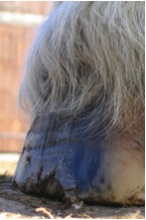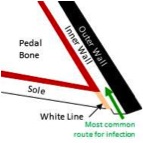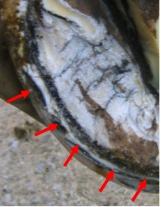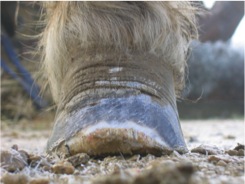White Line Disease: What is it and and How do I control it?
What is White Line Disease?
White Line Disease is characterised by a variety of cracks and fissures that appear in the non-pigmented inner wall of the hoof which, if left unchecked, can eat so far up the hoof wall that it becomes completely unstable.
 The name “White Line Disease” is misleading. For a start it primarily affects the inner wall of the hoof (stratum internum) rather than the white line, and it’s not a disease, it’s an infection. Its latin name is Onychomycosis, which is equally misleading as it means a “fungal infection of the nail”. Even if we ignore the fact that it’s not a nail (it’s a hoof) to assume the infection is fungal is again not always true.
The name “White Line Disease” is misleading. For a start it primarily affects the inner wall of the hoof (stratum internum) rather than the white line, and it’s not a disease, it’s an infection. Its latin name is Onychomycosis, which is equally misleading as it means a “fungal infection of the nail”. Even if we ignore the fact that it’s not a nail (it’s a hoof) to assume the infection is fungal is again not always true.
Onychomycosis doesn’t just affect horse hooves. It has been found not only in humans, but in all sorts of animals including cows1, cats and dogs2 and goats and sheep3. There are some who believe that true Onychomycosis is a fungal infection4, 5, whereas traditionally it is often believed in the farriery profession to be a yeast infection6. However, studies carried out on these hoof wall infections have isolated a whole host of bacteria, fungi and yeast within the hoof wall in greatly varying combinations7.
 So maybe we should be looking at the problem in a different way. Instead of trying to isolate an organism to blame for the damage caused to a hoof wall, maybe we should be viewing the problem from a completely different perspective. The microorganisms found in White Line Disease are likely to be whatever opportune bugs in the horses’ environment have managed to find their way into the hoof wall. A healthy hoof wall is almost impervious to infection, but when horn quality is compromised, tiny faults appear in the hoof wall which allow bugs in. Once they take hold they begin to eat their way up and can do a lot of damage.
So maybe we should be looking at the problem in a different way. Instead of trying to isolate an organism to blame for the damage caused to a hoof wall, maybe we should be viewing the problem from a completely different perspective. The microorganisms found in White Line Disease are likely to be whatever opportune bugs in the horses’ environment have managed to find their way into the hoof wall. A healthy hoof wall is almost impervious to infection, but when horn quality is compromised, tiny faults appear in the hoof wall which allow bugs in. Once they take hold they begin to eat their way up and can do a lot of damage.
 White Line Disease likes to eat into the white Inner Wall of the hoof first. The Inner Wall contains more moisture than the outer wall, and, because it is more flexible than the outer wall, the horn that it is made of is less dense. This will make it easier for microorganisms from the horses’ environment to eat their way into the hoof wall. The best time to spot it is when your farrier/trimmer rasps the inner wall clean. Normal wear and tear will create small cracks in the hoof wall anyway, but if the cracks are still there once the hoof has been trimmed to the correct length, this means that the white line disease is eating into the hoof wall faster than the wall grows and it needs to be dealt with before it takes hold.
White Line Disease likes to eat into the white Inner Wall of the hoof first. The Inner Wall contains more moisture than the outer wall, and, because it is more flexible than the outer wall, the horn that it is made of is less dense. This will make it easier for microorganisms from the horses’ environment to eat their way into the hoof wall. The best time to spot it is when your farrier/trimmer rasps the inner wall clean. Normal wear and tear will create small cracks in the hoof wall anyway, but if the cracks are still there once the hoof has been trimmed to the correct length, this means that the white line disease is eating into the hoof wall faster than the wall grows and it needs to be dealt with before it takes hold.
Serious infection is, thankfully, rare in England and when we do see it, it is telling us that there is something seriously wrong with the integrity of the hoof horn.
What Causes it?
Potential causes of White Line Disease are11:
- Laminitis
- Nutritional Imbalance
- Mechanical Stress on the wall
- Use of harmful hoof dressings
- Standing in faeces for long periods.
Laminitis
When a horse suffers from impaired blood supply to the network of capillaries which provide the nourishment that enables hoof horn to be produced, the result is that the hoof horn produced at this time is weaker, less dense, and more susceptible to infection4, 9, 10. Combine this with the large number of dead horn cells within the inner wall, blood products which have leached into the horn from the damaged laminae and the additional heat from an inflamed hoof and you have a perfect environment for White Line Disease.
 In these instances, the white line disease will grow out once the laminitis is brought back under control, although it may need additional disinfection if the white line disease is particularly bad.
In these instances, the white line disease will grow out once the laminitis is brought back under control, although it may need additional disinfection if the white line disease is particularly bad.
The picture on the left shows a laminitic hoof that has suffeed from pedal bone rotation. You can see that the area of freshly rasped wall at the bottom is exposing damaged hoof horn filled with blood products that provides an ideal environment for infection to take hold.
Nutritional Imbalance
The quality of hoof horn is dictated by the nutritional balance in the horse’s diet. This does not necessarily refer to deficiencies, but excesses can also cause major problems.
Sue Kempson at the Royal (Dick) Veterinary School in Edinburgh has carried out numerous studies on White Line Disease and how nutrition affects it 13, 14, 15. She has found that there are a number of factors which can affect the quality of the hoof horn as it is being produced. Various mineral imbalances can be a factor (in particular the ratio of calcium : phosphorous and excess selenium), as can over-supplementation with certain vitamins, in particular A and D, which happens with some feed balancers. It can also happen when a diet is high in starch such as grains, or refined sugar such as molasses. Inadequate fibre in the diet can also have the same effect.
Mechanical Stress
When a foot is out of balance, or a biomechanical issue in the horse’s body is causing it to twist a foot or significantly weight one side of the foot over another, this can cause sufficient mechanical stress to apply a shearing force to the layers of hoof wall. This creates small defects at the ground bearing surface of the wall which can begin to harbour infection. Obviously imbalances can be corrected with careful trimming, but biomechanical imbalances may need to be corrected by a good equine bodyworker to reduce or eliminate the shearing action and allow the infection to grow out. Sometimes the stresses placed on the wall are from poor conformation or joint problems such as arthritis, in which case the condition will just have to be managed with a combination of careful trimming and good hoof hygiene. Mechanical stress can also include holes made by nails in shod horses. These not only harbour bacteria, but because the hoof wall flexes around the nail, this creates additional damage which allows bugs to enter the hoof wall.
Use of Harmful Hoof Dressings
Most of the bugs that cause White Line Disease are fairly innocuous and very easy to eliminate. However, problems occur when people use substances that are too caustic and drying, causing the healthy hoof horn around the area being treated to begin to dry out and become food for the bugs, making the problem worse. Common hoof dressings that often exacerbate White Line Disease are:
| Hoof Oil | It may make hooves shiny but can make poor hoof horn worse. Don’t just take my word for it Hoof Dressings, what studies show |
| Stockholm Tar | a highly noxious product used for treating wood which should never be used on hooves, not only because it eats into hoof horn, but also because it is poisonous |
| Hydrogen Peroxide | Many people apply neat Hyrogen Peroxide at 35% concentration. If you want to stop it from dissolving away healthy hoof horn the concentration needs to be no more than 1.5% (3% diluted 50:50 with water) |
| Formalin based hoof dressings | These are very drying and will kill off the waxy lipids in hoof horn and make it dry and brittle, causing more microcracks which harbour more bugs |
| Engine oil | Don’t. Just don’t. It is poisonous to the horse, irritates the skin and breaks down hoof horn |
| Iodine | This dries out hoof horn and makes it brittle, causing more cracks which allow bugs in |
| Sugardine (sugar and iodine mixed) | Considered to be less harmful than neat iodine, but it still has the same detrimental effect on horn quality |
| Purple Spray or Foot Rot Sprays containing Violet | Although the gentian violet, which gives the product its characteristic colour, is fairly innocuous (although there are suggestions that it is mildly carcinogenic17), in order for it to be an effective spray it is delivered mixed with products such as ethanol which is drying |
Standing in Faeces for Long Periods
If your horse lives in, or likes to stand in his own pooh, this could be enough to cause White Line Disease. A horse’s dung is full of the bacteria, fungi and protozoa from the hind gut that were used to digest the horse’s food. Once excreted they stay alive in the horse pooh for a while, and continue to feed on whatever food sources are in its environment. Hoof horn is very tasty to these bugs – in fact studies carried out by Sue Kempson16 found equine faeces were very efficient at breaking down hoof horn – far more efficient than stale urine which is commonly thought to “soften” feet (it doesn’t).
How Do We Treat It?
Thankfully, there are many products available that are very effective in treating hoof horn, and thankfully, most of them are easy and cheap to obtain. Initially you should disinfect using a hoof soak which will penetrate deep into the hoof and kill off the hoof horn. Use either of these:
| Cleantrax | The crème da la crème of hoof disinfectants. It is a hoof soak that penetrates deep into all of the cracks and crevices where bugs are hiding and obliterates them without harming the healthy hoof horn. If you have a significant infection, this should be your first choice. Available in the UK from www.equinepodiatrysupplies.co.uk. |
| Milton | Milton liquid (not the tablets) is meant for sterilising baby bottles, but it is a very effective, cheap and easy to obtain hoof soak. Don’t use it more than twice weekly, and at a concentration of 1 capful to 5 litres of water. That is enough to kill the bugs without drying out the hoof horn. |
Once the hoof has been disinfected and allowed to dry thoroughly, you need to keep the bugs at bay. The best way is to coat the hoof with a flexible, non-drying, antibacterial, antifungal gel that sticks to the hoof and hides in the crevices. These products are very effective and can be re-applied every 2-3 days for maximum effectiveness:
| Red Horse Field Paste | Meant to be a thrush treatment for horses who don’t have their feet picked out often, this product is brilliant at hiding in cracks and fissures and killing off bugs in the hoof wall. |
| Red Horse Arti-mud | A similar preparation to Field Paste, this product is just as effective, and neither will dry out the hoof. |
| Sudocreme | Meant to be a treatment for nappy rash, this versatile product can be smeared onto hoof horn with no ill effects and is very effective at killing bacteria and fungi |
| White Lightening | Available as a spray or a gel, this product will obliterate bugs and cling to cracks and crevices. Available from www.equinepodiatrysupplies.co.uk. |
Of course, if you want White Line Disease to be banished for good, you need to make sure you have identified and tackled the potential cause or causes. This will enable you to grow out the infected horn leaving you with healthy, infection free hooves that resist bugs naturally, meaning you no longer have to spend time and money fighting recurrent infections.
This article has been written and kindly donated by Jayne Hunt (www.healthyhooves.co.uk). Jayne is a professional Equine Podiatrist and trainer who specialises in Equine Anatomy and Physiology, which she teaches to students studying the two year Diploma in Equine Podiatry course with Equine Podiatry Training Ltd www.eptrain.co.uk.
References
1 EDWARDS, G.B. (1980) White line disease of the foot in cattle. In: The Veterinary Annual, 20th edn. Eds: C.S.G.Grunsell and F.W.G.Hill. Scientechnica, Bristol. pp 227–233
2 CARETTA, G., MANCIANTI, F. and AHEKKIM L. (1989) Dermatophytes and Keratinophilic Fungi in Cats and Dogs. Mycoses 32, 620–626
3 ABDEL-HAFEZ, A.I.I., MOHARRAM, A.M. and ABDEL-GAWAD, K.M. (1990) Survey of keratinophilic and saprobic fungi in the clovenhooves and horns of goats and sheep from Egypt. J. Basic Microbiol.30, 13–20
4 KUWANO, A., YOSHIHARA, T., TAKATORI, K. and KOSUGE, J. (1998), Onychomycosis in white line disease in horses: pathology, mycology and clinical features. Equine Veterinary Journal, 30: 27–35. doi: 10.1111/j.2042-3306.1998.tb05119.x
5 LARONE, D.H. (1995) Medically Important Fungi: A Guide to Identification, 3rd edn. ASM Press. Washington. DC
6 GALLENBERGER, M.R. (1994) “Forget the yeast infection-it’s a hoof fungus!”Am. Farriers J.20, 48–50
7 SHAKALIS, R.M. and PAUTIENIS, M.J. (1994) Taking a closer look at white line disease. Am. Farriers J.20, 61–66
8 O-GRADY, S.E.(2006) How to Manage White Line Disease, AAEP Proceedings 2006 Vol 52, 520-525
9 COLLINS, Simon N., Andrew W. Van EPS, Christopher C. Pollitt, and Atsutoshi Kuwano. “The lamellar wedge.” Veterinary Clinics of North America: Equine Practice 26, no. 1 (2010): 179-195.
10 OKE, Ray A. “Unilateral white line disease and laminitis in a quarter horse mare.” The Canadian Veterinary Journal 44, no. 2 (2003): 145.
11 TURNER, T. A. (1998), White line disease. Equine Veterinary Education, 10: 73–76. doi: 10.1111/j.2042-3292.1998.tb01785.x
12 KEMPSON, S.A. ROBB, R. (2004), “Use of a Topical Disinfectant as part of a hoofcare programme for horses with diseases of the hoof capsule”, The Veterinary Record 22 May 2004 154, 647-652
13 KEMPSON, S.A. (2005), “Nutritional Management of Horses with Hoof Diseases”, ENUCO 2005 105-111
14 KEMPSON, S.A. (1987) “Scanning Electron Microscopic Study of Hoof Horn from Horses with Brittle Feet”, Vet Record 120, 586-587
15 KEMPSON, S.A. (1990) “Ultrastructural Observations on the Response of Equine Hoof Defects to Dietary Supplementation – a Scanning Electron Microscopic Study”, Vet Record, 124, 37-40
16 KEMPSON, S. A. & ROBB, R. (2004) Infections of equine hoof horn. In Corrective Farriery. Vol 2. Ed S. Curtis. Newmarket, R & W Publications. (In Press)
17 DRINKWATER, Paul (1990), “Gentian Violet — Is It Safe?”, The Australian and New Zealand Journal of Obstetrics and Gynaecology 30: 65